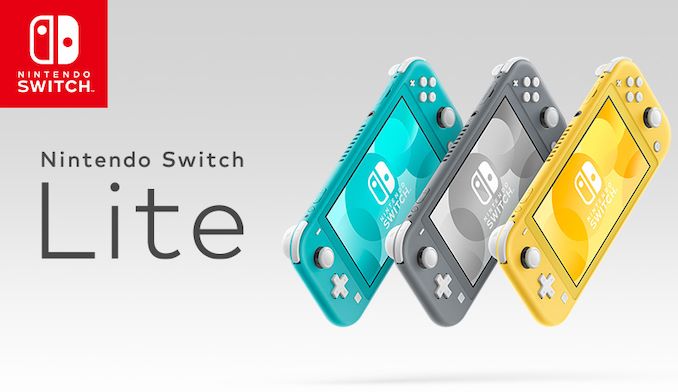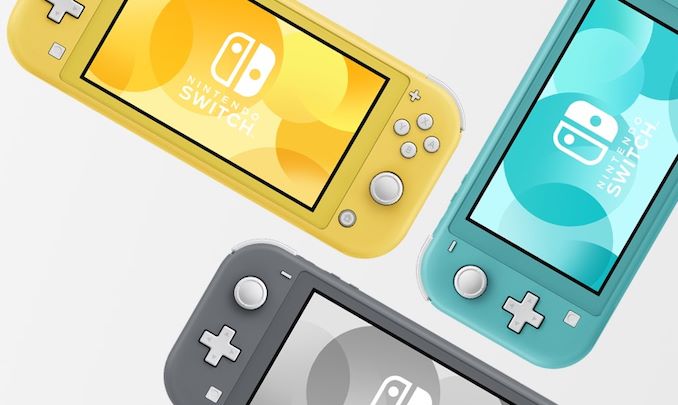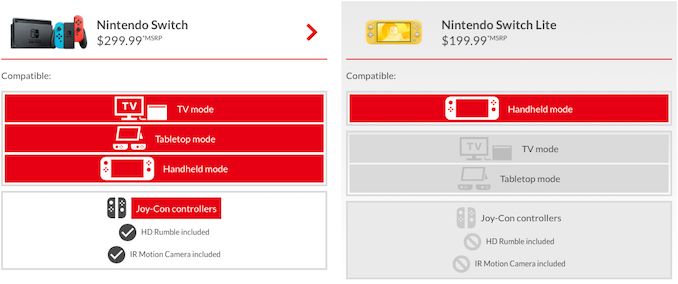Update: Nintendo Reveals Handheld-Only Switch Lite, With a New NVIDIA SoC
by Anton Shilov on July 10, 2019 4:00 PM EST
Nintendo has announced a new version of its Switch game console that only works in handheld mode, yet it is considerably more compact, comes at a lower price point, and works for a longer time on one charge. One of the intrigues about the Switch Lite device is that it might be is powered by a new NVIDIA Tegra SoC, presumably made using a more advanced process technology.
The Nintendo Switch Lite comes with a 5.5-inch LCD featuring a 720p resolution and has built-in controllers that have the same layout as Nintendo’s Joy-Con controllers. The console will support local and online multiplayer modes and will allow up to eight people to play at once anywhere with Wi-Fi. When it comes to style, the gaming device will come in grey, yellow, and turquoise to attract gamers with different tastes. As far as availability is concerned, the Switch Lite will ship on September 20 and will cost $199.99 (down from $299.99 in case of the fully-fledged version).
Since the console is designed for games that support Handheld mode, it cannot connect to TV, work in tabletop mode (because it does not have a kickstand), is not compatible with the Switch dock, does not support HD Rumble as well as IR Motion Camera. The said limitations are fully justified for mobile gaming as the new Switch Lite console is considerably more compact, it weighs 122 grams (0.27 pounds) less, and it works for three to seven hours (up from 2.5 – 6.5 hours in case of the original Switch). The more notable battery life comparison is the 3 hour vs 4 hour gameplay estimate given for Zelda's Breath of the Wild, which is a 33% increase over the original Switch, pointing out to larger efficiency boosts of the hardware.
The longer battery life of the Switch Lite, despite its smaller dimensions (and a lower-capacity battery) may indicate that the SoC inside the Switch Lite – which NVIDIA has confirmed they're powering – is based on an updated Tegra design produced on a more advanced fabrication process. The original Tegra X1 chip was manufactured on TSMC's 20nm process node, which was not exactly the best node when it comes to power efficiency. Recently we've seen evidence of a revision of the X1 with notable changes in the operating voltages of the chip, which point out that this very well might be a die shrink. We believe that it's likely that the new chip is manufactured in a 16nm or 12nm process node.
| Nintendo's Handheld Game Console Specification Comparison | |||||
| Nintendo Switch | Nintendo Switch Lite | ||||
| SoC | NVIDIA Tegra X1 4x ARM Cortex-A57 NVIDIA Maxwell (256 CUDA Cores) |
NVIDIA SoC (12/16nm Tegra X1 Shrink?) |
|||
| Display | 6.2-inch 1280x720p LCD (HDMI: 1080p60) |
5.5-inch 1280x720p LCD | |||
| Size | 102 x 239 x 13.9 mm, 297g (tablet only) 398g w/Joy-Cons |
91.4 x 208 x 13.9 mm, 277 g | |||
| Battery | 4310 mAh (~ 16Whr) 2.5 to 6.5 Hours 3 hours BotW gameplay |
3570 mAh (~13.2Whr) 3 - 7 Hours 4 hours BotW gameplay |
|||
| Storage | 32 GB NAND + microSDXC | 32 GB NAND + microSDXC | |||
| Wireless | 802.11ac Bluetooth 4.1 |
802.11ac Bluetooth 4.1 |
|||
| I/O | Console | USB Type-C | USB-C (power only)- | ||
| Dock | 1x USB 3.0 2x USB 2.0 1x HDMI 1.x 1x USB-C (power only) |
||||
| Launch Date | 03/03/2017 | 09/20/2019 | |||
| Launch Price | $299 | $199 | |||
Neither Nintendo nor NVIDIA have confirmed usage of a new Tegra X1 inside the Switch Lite console.
One interesting note is that while Nintendo hasn't detailed the specifications of the new handheld, they have allowed partner NVIDIA to confirm that they're powering it, leading a good deal of further credit to the theory that the console is being powered by a die shrunk descendant of the Tegra X1.
#WePowerIthttps://t.co/l3AKDR1pD4
— NVIDIA GeForce (@NVIDIAGeForce) July 11, 2019
NVIDIA, of course, was a close partner in developing the original Switch. Along with providing the Tegra X1 SoC inside of it, NVIDIA has supplied a good chunk of the graphics software stack, with Nintendo opting to leverage their experience there. Using another NVIDIA SoC was a foregone conclusion for the Switch Lite, given the compatibility needs, but with secretive Nintendo it's rare to get official confirmation so early on.
Meanwhile, as soon as the Japanese gaming giant launches the new product in September, we will find out for sure what is inside after the console gets teared down.
Related Reading:
- Playing With Power: A Look At Nintendo Switch Power Consumption
- Nintendo Switch Hardware Launch Details - 32GB w/Expandable Storage, 6.2” 720p Screen, 2.5 to 6.5 Hour Battery Life
- Nintendo Announces Switch Portable Gaming Console - Powered by NVIDIA Tegra
Sources: Nintendo, Nintendo.de












51 Comments
View All Comments
WPX00 - Thursday, July 11, 2019 - link
I know for a fact the A57 can support 14nm. Look at the Samsung 7420.Wardrive86 - Thursday, July 11, 2019 - link
Im fairly certain Samsung just successfully tested their 5nm LPE with Cortex A57rocky12345 - Wednesday, July 10, 2019 - link
I'm not a switch fan but that is just my own opinion. I do however this is even worse than the regular switch because it will pretty much always be stuck in switch economy performance mode so the games that run better when the full switch is plugged into it's dock will run at the slower rate 100% of the time. Besides that the regular switch can already be used as a full time handheld and 30 minutes extra game play makes this to me at least pointless product release and just another avenue for them to collect more money from suckers. This is just my opinion of coarse I am sure there will be lots of people that will think this is the greatest thing since sliced bread.PeachNCream - Wednesday, July 10, 2019 - link
I'm not a switch fan either. The last place I'd want to be is crammed inside that tiny casing and the last thing I'd want to have to do is spin around constantly to move enough air to keep the SoC from melting into silicon slag.pbollwerk - Wednesday, July 10, 2019 - link
I already have a hard time reading text on the switch in handheld mode. And I find the joycons quite uncomfortable. Not sure a smaller screen is good, unless there is a way to make the ingame text larger or more readable.Alistair - Wednesday, July 10, 2019 - link
yeap this is for kids with great eyesight basicallyTEAMSWITCHER - Thursday, July 11, 2019 - link
The Switch's best game "The Legend of Zelda - Breath of the Wild" is a fantastic cinematic experience that I think plays best in dock mode on a big screen with the Pro Controller.I am reminded of what Director Ridley Scott said about people watching movies on their smart phones... "I don't make films for tiny screens."
peterfares - Wednesday, July 10, 2019 - link
I find it odd that they chose to drop the HDMI output from the USB-C port. That can't add very much cost and has the potential of selling docks to buyers who chose to go for the Switch Lite to save a little money up front. The docks are very expensive for what they are so must have a lot of profit margin in them.michael2k - Wednesday, July 10, 2019 - link
The USB-C hardware has to handle https://en.wikipedia.org/wiki/HDMI#HDMI_Alternate_... on the full switch, which I believe also requires implementation of the Power Delivery to be implemented.By cutting out HDMI out they can simplify the hardware to remove the need for both Power Delivery and Alternate Mode, and present itself as a simple USB device and only pull power for charging, using either the Battery mode or the standard Type C mode.
timecop1818 - Wednesday, July 10, 2019 - link
Switch never supported "HDMI Alternate Mode" and I'm not actually aware of any device that does.Switch uses (after non-standard negotiation) DisplayPort alternate mode 2 with 2-lane DP 1.2 and USB3.x on remaining highspeed lanes. The dock has a DP to HDMI converter IC (megachips something or other), and switch itself never outputs HDMI.